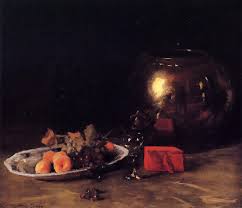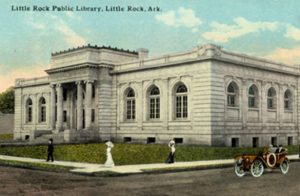For about five years now, I’ve been trying to learn to draw and paint, mostly through the Continuing Education program at the Pennsylvania Academy of the Fine Arts. Last week my instructor suggested that I try copying paintings. What I learned when I tried taught me something about painting and art criticism, but also something about what is, depending on how you look at it, either my job or my chief vocation: classical studies.
I set out to copy William Merritt Chase’s “The Big Brass Bowl,” now in the Indianapolis Museum of Art. I had seen it at the Museum of Fine Arts in Boston in the exhibit “William Merritt Chase: Modern Master” and had a copy of the catalog. Here it is, courtesy of Wikiart:

First I made a very quick—about 15-minute—watercolor sketch. That taught me that there are five important things in the picture. Three of them stand out when you see the painting: the bowl, the plate (but not, I thought, the fruit in it), and the red box. Doing the sketch showed me that two other things matter to the painting just as much: the reflection of the box in the bowl, and the background along with the table surface, treated as a single graded area of color from black at the top to dark yellow ochre at the bottom. It’s also important that the black of the background is almost impossible to distinguish from the edges of the bowl.
Then I taped a piece of oil paper to my easel and set to work. Here’s what happened:

Painting this copy taught me a great deal more than the watercolor drawing had. First, I learned that the proportions of Chase’s canvas help to make the painting work. The original painting is almost square, about 35″ x 40″. My sketch was 9″ x 12″, and my painted copy is even smaller at about 7″ x 8″, but its relative proportions are the same as Chase’s. Keeping Chase’s proportions allowed me to understand how carefully he had arranged the objects on his field, with the right-hand edge of the plate and the left-hand edge of the bowl each overlapping the center line of the canvas. Then, when I’d laid in the five important pieces that emerged from the sketch, I saw that the fruit in the bowl really had to be there. The grapes on the tabletop in the left foreground are essential to giving a sense of depth and taking your eye into the painting, along a diagonal from the reddish grapes to the red box, and beyond it to its reflection in the bowl. Without them, there’s just too much tabletop. (And look how the red box on the other side sucks up the energy in that part of the painting, so that the wrinkles in the fabric in front of it are enough to fill the space.) The grapes on the table make no sense without the other fruit on the plate–and in the much larger original, the wonderful still life that Chase embedded in the left center of his canvas matters even more.
I also learned a lot from what didn’t succeed in my copy; in fact, I probably learned more about painting from the copy’s failures than from its successes. I didn’t, for example, succeed in copying Chase’s tonal gradations; there’s too much contrast in my copy between the foreground tablecloth and the black background, and between the midtones of the bowl and the dark edges, and not enough between the fruit and the rest of the painting. You’ve probably noticed that I left out the wineglass; the truth is, I don’t understand what its job is in the painting.
This exercise may have made me a little better as a painter, but it made me a much more perceptive critic of Chase’s still life. I have, in a way, begun to reverse engineer it to see how it works. And this takes me to classics. When we classical scholars—and I’m going to limit my subject to scholars of Greek and Latin literature—practice our craft, we are critics, and with rare exceptions we are analyzing things that we do not know how to make. Few if any scholars of Greek or Latin poetry also write poetry in any language. A few more engage in the wonderful parlor game called “composition,” which consists of translating from a modern language into Greek or Latin verse, but I have a sense that even that practice is now uncommon. That’s why I have been glad to see the move toward “active Latin” or “living Latin” gain steam, thanks to the work of the Paideia Institute and others. It’s not terribly important to be able to order a hamburger in Latin, although it’s fun to be able to get elaborate public jokes like the signs at the Wallsend Metro Station. it is important, though, to have some sense, however imperfect, of what Vergil or Ovid were up to. A few years ago I had a group of students who got far enough in Pantin’s First Latin Verse Book to be able to turn English translations of some of Ovid’s poems into Latin verse. Reverse engineering Ovid’s work and then comparing their copies to his original gave them a better insight into his artistry than anything I could have said in class. So let’s write Latin and copy paintings—not because we want to become poets or painters, but because the better we are at reading and thinking and seeing, the better we will become at being human.
–Lee T. Pearcy

